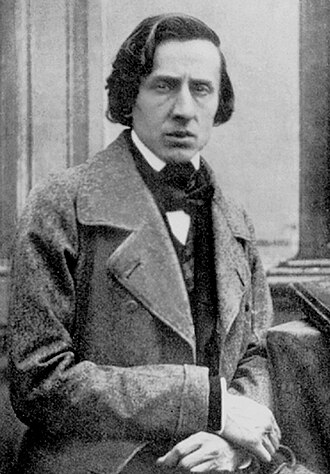Mazurkas, Op. 63 (Chopin)

The Op. 63 Mazurkas by Frédéric Chopin are a set of three mazurkas for solo piano written in 1846 and published in 1847. These were Chopin's last set of mazurkas published during his lifetime. They demonstrate the composer's "late" style and may suggest a maturity of his emotional approach to the mazurka as a musical form.[1]
Analysis
[edit]Mazurka in B major, Op. 63, No. 1
[edit]The first of the Op. 63 Mazurkas, B major and marked Vivace, begins with a lively theme typical of Chopin's mazurkas. This is immediately followed by a more simple second theme which has a rustic feel. Throughout the piece, feelings of animation and excitement present in the main theme are contrasted by the simplicity and warmth of the second theme. Overall, this mazurka is very rhythmic and full of flourishes. It lasts about two and a half minutes.[1][2]
Mazurka in F minor, Op. 63, No. 2
[edit]The second Mazurka of the set, marked Lento and set in the nostalgic key of F minor, is melancholy and introspective in character. The main theme is quite beautiful and noble in character. The middle section, in A-flat major, allows a brief respite from the solemn atmosphere. Soon, however, a reprise of the main theme is heard, which then fades in a descending chromatic episode. The piece demonstrates Chopin's mastery of lyricism, along with subtle nuances in the inner voices. It is the shortest mazurka of the set and takes under two minutes to perform.[1][3]
Mazurka in C-sharp minor, Op. 63, No. 3
[edit]The final mazurka of the Op. 63 set is a true kujawiak, a national polish dance slightly slower than a mazurka. Written in the key of C-sharp minor, it is songful in character with an innocent and expressive melody as the main theme. This is followed by a short section marked sotto voce which invokes the seemingly forgotten mazurka spirit. However, it then quickly leads to the reprise of the main theme, this time in a modified form with counterpoint, which intensifies the mood and the piece ends in dramatic fashion. Throughout, Chopin's innovative use of contrapuntal devices and different textures creates an intimate and mournful atmosphere. It takes around two and a half minutes to perform.[1][4]
References
[edit]External links
[edit]- Mazurkas, Op. 63: Scores at the International Music Score Library Project